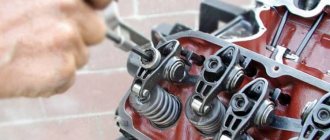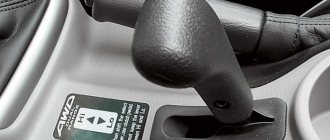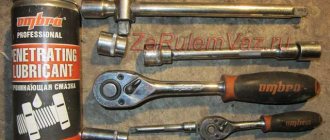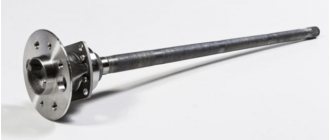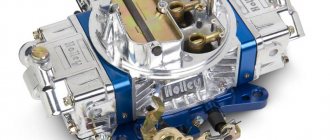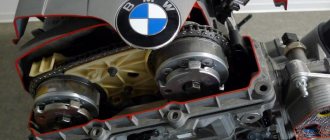Vehicle weights
The actual weight of the car is 1045 kilograms. The main units of the “six” have the following weight:
- 140 kilograms - engine with equipment (starter, generator, carburetor, etc.);
- 26 kilograms - gearbox;
- 10 kilograms - square shaft;
- 52 kilograms - rear gearbox;
- 7 kilograms - radiator grille;
- 280 kilograms - car body.
It is noticeable that the body is the heaviest structural unit of the car. It weighs as much as two engines with all the components. The remaining mass of 530 kilograms is scattered between interior trim parts, wheels, fuel lines, brake lines and other things, the discrepancy in mass of which does not reach such large values.
An interesting fact is that according to all the norms and standards of the Soviet economy, the “six”, having an actual weight of 1045 kilograms, fell into the category of small class vehicles, but at the same time, thanks to the engine capacity of the VAZ 2106, it was a full member of group number three.
Main characteristics of the “six”
VAZ 2106 is considered a Soviet and Russian car, produced in the period 1975-2005. The car was manufactured and produced at VAZ, but already in 1998 some production facilities were moved to Syzran and Kherson. In 2002, the “six” was assembled at IzhAvto, where the last model of the legendary car was left on the assembly line.
It will be interesting to know: in total, over 4,300 million VAZ 2106 units have been produced in the entire history of the automotive industry at various factories.
The “Six” was also produced in several modifications. Regarding the body, the following noteworthy points can be made:
- The modification of the VAZ 21061, intended for sale in Canada, had a completely different body installed. This one had special aluminum bumpers and fangs. The bumper also had trims and ends made of black plastic;
- The VAZ 21063 body was equipped with “five” bumpers;
- The body of 21065 was also equipped with aluminum bumpers, and some of the cars going for export were generally modified;
- The VAZ 2121 was equipped with a body with the same bumpers as on the export 21061, only without sidelights.
Symptoms of a problem
As soon as the driver notices any changes in the operation of the rear axle (for example, extraneous sounds appear that were not there before), he must respond to these changes as quickly as possible so as not to aggravate the possible malfunction. The most typical sign of such problems may be increased noise levels:
- coming from the rear wheels;
- during operation of the rear axle;
- when accelerating the car;
- when braking with the engine;
- during engine acceleration and braking;
- while the vehicle is turning.
In addition, a knocking sound when the car starts moving and an oil leak may indicate a malfunction of the rear axle.
Oil leakage indicates a malfunction of the rear axle of the VAZ 2107
Grinding noise when moving
The causes of a grinding noise from the rear axle when the vehicle is moving can be:
- wear or destruction of axle or differential bearings;
- deformation of the beam or axle shafts;
- incorrect adjustment, damage or wear of gears or bearings of the gearbox and differential;
- wear of the spline connection with the semi-axial gears;
- incorrect adjustment of the gear teeth of the main gear;
- insufficient amount of oil.
The cardan spins, but the car does not move
If the driveshaft rotates while the vehicle is stationary, the cause may be a failed axle spline or wear on the teeth of the differential or final drive gears. In any case, if the cardan spins, but the car does not move, this indicates a fairly serious breakdown and, most likely, replacement of the axle shafts, bearings or gears will be required.
Oil leakage from the housing and from the shank side
The most likely causes of oil leakage from the rear axle housing:
- wear or damage to the drive gear seal;
- wear of the axle shaft seal, determined by oiling of the brake shields, drums and pads;
- loosening the bolts securing the rear axle gearbox housing;
- damage to sealing gaskets;
- axial play of the shank;
- breather jamming.
Wheels are stuck and won't rotate
If the rear wheels are jammed, but the drum and pads are in order, the cause of this malfunction may be failure of the bearings or the axle shaft itself. Most likely, in this case, the bearings have crumbled or the axle shaft has become deformed (for example, due to an impact) and the parts need to be replaced.
How much does the Zhiguli bridge weigh?
Perhaps one of the most popular cars in the post-Soviet space was, is and remains the VAZ. This car has captivated many generations. However, how did it all begin? When was the first VAZ car produced and how much did it weigh? You will learn the answers to these and other questions from this article.
The first VAZ car was produced by the Volzhsky Automobile Plant on April 19, 1970. The make of this car was VAZ-2101 Zhiguli. Its production was carried out according to the analogue of the Fiat concern. Moreover, VAZ owes its appearance to this particular brand of Fiat 124, produced in 1966. Here, in fact, is it:
As a result of some design improvements, the first domestic car, the VAZ 2101 of 1970, was produced:
The weight of this car was 955 kg. Moreover, of this mass the engine weighed 114 kg.
It has not lost its popularity to this day. In 2000, it was recognized as the best car among eighty thousand car enthusiasts surveyed in the CIS countries and Russia. It was named the best car of the century, VAZ 2101. At the time of its production, it was considered the most comfortable, reliable and modern domestic car. Its presence was a sign of wealth and prosperity!
But the Volzhsky Automobile Plant did not stop there. He created entire collections of this car. Each of them differed in its configuration, as well as its total weight. Therefore, now we will compare some VAZ models by their weight.
- VAZ 2102 has a weight of 1010 kg .
- VAZ 2103 has a weight of 965 kg .
- VAZ 2104 has a weight of 1020 kg .
- VAZ 2105 has a weight of 1060 kg .
- VAZ 2106 has a weight of 1045 kg .
- VAZ 2107 weighs 1049 kg .
- VAZ 2108 weighs 945 kg .
- VAZ 2109 weighs 915 kg .
- VAZ 2110 has a weight of 1020 kg .
- VAZ 2111 has a weight of 1055 kg .
- VAZ 2112 has a weight of 1060 kg .
- VAZ 2113 weighs 975 kg .
- VAZ 2114 weighs 985 kg .
- VAZ 2115 has a weight of 1000 kg .
- VAZ 2116 weighs 1276 kg .
- VAZ 2117 has a weight of 1110 kg .
- VAZ 2118 has a weight of 1110 kg .
- VAZ 2119 has a weight of 1110 kg .
- VAZ 2120 has a weight of 1110 kg .
- VAZ 2121 has a weight of 1550 kg .
- VAZ 2122 has a weight of 1122 kg .
- VAZ 2123 has a weight of 1300 kg .
Replacing the rear axle of a VAZ 2106
When it is necessary to replace the rear axle of a vehicle such as a VAZ 2106, you will need to acquire special tools for working with this unit. A standard driver kit is provided for this. In this case, you cannot do without a liquid intended for degreasing surfaces. So, experts recommend using white spirit and gasoline.
In order to dismantle the rear axle, you must:
- install the car using a pneumatic lift (repairs can also be performed on an overpass or by driving the vehicle into a deep pit intended for inspection);
- drain the engine fluid into a container and disconnect the universal joint with a part such as the flange mount of the shank;
- dismantle the axle shaft of the humming rear axle, unscrew the fastening element, align the rear axle gearbox with its beam;
- replace the unit, make adjustments if necessary, check the unit for operability;
- clean the structural elements of the unit, degrease the oil seal and bearings, fastening components;
- connect the gearbox to the rear beam of the vehicle and, using the cross technique, tighten the fasteners.
- pour motor fluid into the unit.
Rear gear ratios of other cars
The gearboxes of VAZ cars are more or less clear. What about other cars? For example, the Gorky Automobile Plant has a large number of modern models of both medium-duty and passenger trucks. The most popular GAZ models are the Gazelle GAZ-3302 and Sobol GAZ-2752. If we do not consider all-wheel drive modifications of these cars, then the rear gear ratio will be either 5.125, or 4.556, or 4.3.
The highest-torque gearbox went to GAZ vehicles with ZMZ406 and ZMZ402 engines. It has the best power characteristics and is recommended for car owners transporting heavy loads and working in harsh conditions. A gearbox with a lower number will give greater dynamics, like a faster one. In this case, a relatively shorter service life should be noted.
To complete the picture, let’s consider foreign versions of gearboxes and their numbers. A good option for comparison would be the rear-wheel drive models of the German auto giant BMW. BMW gear ratios range from 3.07 to 4.1. Moreover, the number of unit models exceeds ten. Just from this indicator you can understand how often foreign designers make changes to car components.
The most dynamic gearbox with a number of 3.07 is found in models of the E90, E91 and E92 series. If we look at powerful options, we can highlight the BMW X5 with a 3-liter engine, which has a rear gear ratio of 4.1.
Other parameters of VAZ 2101:
| VAZ 2101 1982 – detailed dimensions |
| VAZ 2101 bodies - detailed dimensions |
| VAZ 2101 cylinders - detailed dimensions | |||
| Length max (mm) Minimum overall length of the car for different modifications of VAZ 2101 Measured in millimeters (mm) | Modifications Number of modifications of the model in our database | ||
| (General form) | 4043 (mm) | 4073 (mm) | 4 |
| Parameters of VAZ 2101 bodies | |
| Parameter Body parameter | |
Caution: the above data are the official figures of the manufacturer, however, please note that the information is for reference only and does not guarantee absolute accuracy.
Rear suspension device for VAZ 2101, 2102
1 – spacer sleeve; 2 – rubber bushing; 3 – lower longitudinal rod; 4 – lower insulating gasket of the spring; 5 – lower spring support cup; 6 – suspension compression stroke buffer; 7 – bolt for fastening the upper longitudinal rod; 8 – bracket for fastening the upper longitudinal rod; 9 – suspension spring; 10 – upper spring cup; 11 – upper insulating gasket of the spring; 12 – spring support cup; 13 – rod of the rear brake pressure regulator drive lever; 14 – rubber bushing of the shock absorber eye; 15 – shock absorber mounting bracket; 16 – additional buffer for suspension compression travel; 17 – upper longitudinal rod; 18 – bracket for fastening the lower longitudinal rod; 19 – bracket for fastening the transverse rod to the body; 20 – rear brake pressure regulator; 21 – shock absorber; 22 – transverse rod; 23 – pressure regulator drive lever; 24 – holder of the lever support sleeve; 25 – lever support sleeve; 26 – washer; 27 – spacer bushing The rear suspension of the VAZ 2101, 2102 car is dependent, includes a guide device, elastic elements and devices that dampen vibrations.
Suspension and wheels of VAZ 2107
Front suspension: independent, on double wishbones, with anti-roll bar and hydraulic shock absorbers. Rear suspension: dependent, with a rigid rear axle beam and 5 reaction rods, on hydraulic shock absorbers.
Standard VAZ 2107 wheels: 5Jxl3H2 with an offset of 29 mm, mounted on 4 bolts with a hole diameter of 98 mm, hole diameter for the hub - 58.5 mm) Tires: tubed or tubeless 175/70R13 or 165/70R13
Recommended tire pressure: - front wheels - 1.7 kg/cm2 - rear wheels - 2.0 kg/cm2
For a softer and more comfortable ride, you can reduce it by 0.1 kg/cm2
Signs of gearbox problems
The rear gearbox is one of the reliable mechanisms of classic Zhiguli cars and breakdowns rarely occur with it. However, like any other unit, it may have its own malfunctions, which are determined by characteristic symptoms. They are worth dwelling on in more detail.
Noise when accelerating
If during acceleration there is an extraneous sound from the gearbox installation site, then it can be caused by:
- worn out or incorrectly adjusted differential bearings. It will require dismantling, disassembling and diagnosing parts with subsequent adjustment;
- Incorrect meshing of the teeth of the main pair gears. Eliminated by proper adjustment;
- lack of lubrication in the gearbox. The lack of oil in the crankcase is restored, after which it is checked for leaks at the places where the sealing elements are installed.
Noise when accelerating and braking the engine
If noise occurs both during acceleration and during braking by the power unit, there may not be many reasons:
- deterioration or failure of the bevel gear bearings of the main pair. Eliminated by replacing failed elements;
- Incorrect adjustment of the gap between the tip and the planetary gear. The mechanism needs to be diagnosed and replaced with damaged parts, as well as setting the required gap between the gear teeth.
Video: how to determine the source of noise in the rear axle
Knocking, crunching noise when moving
If the gearbox begins to make sounds uncharacteristic of its normal operation, then it will be possible to accurately diagnose the breakdown only after disassembling the unit. The most likely causes of a crunching or knocking sound may be:
- tooth breakage on the gears of the main pair;
- great wear of the main pair;
- Problems or incorrect adjustment of the bevel gear bearings.
Noises when turning
Noise in the gearbox is also possible when turning the car. The main reasons for this phenomenon may be:
- tight rotation of the satellites or the appearance of scratches on their surface. Eliminated by replacing damaged parts or treating roughness with sandpaper. If the defect cannot be removed, the failed parts must be replaced;
- jamming of side gears. If the gears have barely noticeable damage, clean them with sandpaper. Elements with signs of heavy wear are replaced with new ones;
- The gap between the differential gears is set incorrectly. It is necessary to set the correct gap between the gears;
- defective semi-axial bearings. The ball bearings need to be replaced with new ones.
Knock when starting to move
The appearance of a knock in the rear gearbox of a VAZ 2106 at the beginning of movement may be accompanied by:
- large gap between the splines of the bevel gear shaft and the flange. It is necessary to inspect the condition of both parts. If significant wear is detected on the splines, the elements are replaced;
- increased gap between the teeth of the main pair gears. The problem is “cured” by adjusting the gap;
- large amount of space for the pinion axle in the differential box. The box needs replacing;
- The fastening of the reaction rods of the rear beam has become loose. It is necessary to inspect and tighten the fastening.
Gearbox jammed
Sometimes the REM may jam, i.e. torque will not be transmitted to the drive wheels. The reasons that can lead to such a malfunction are as follows:
- lack of lubricant in the mechanism, which could leak due to leakage of the unit;
- failure of satellites;
- damage to the bearing on the bevel gear of the main pair.
Lack of lubrication in the gearbox leads to increased production and jamming of the mechanism
Oil leakage can be determined without disassembling the gearbox, but other faults cannot be identified without this procedure. If, after disassembly, scuffs, broken teeth or visible damage to the bearing are found on the gears, then the parts need to be replaced.
Oil leak
Lubricant leakage from the “six” gearbox is possible for two reasons:
- failure of the shank oil seal;
- damage to the gasket between the gearbox and the rear axle stocking.
To accurately determine where the oil is leaking from, you need to wipe off the lubricant with a rag and after a while inspect the gearbox: the location of the leak will be noticeable. After this, you can take further actions - remove the entire gearbox to replace the gasket, or dismantle only the cardan and flange to replace the lip seal.
An oil leak is indicated by a wet gearbox in the lower part.
Recommendations
Comments 52
Will you build a flying ship? — I’ll buy
